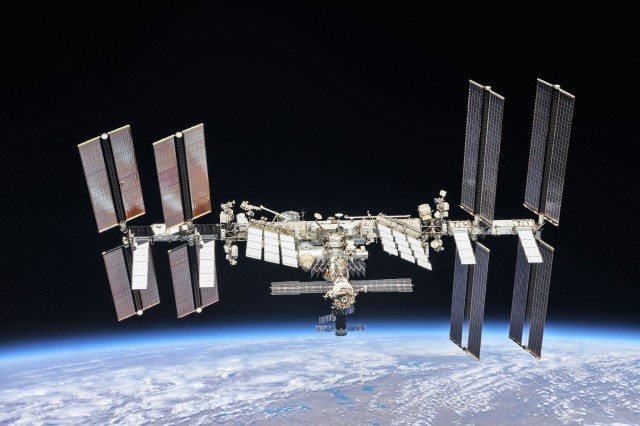Description

Disclaimer: Copyright infringement not intended.
Context
- International Space Station (ISS) stands as a testament to international collaboration and scientific advancements in space exploration.
- After 25 years in orbit, it continues to serve as a hub for research and peaceful cooperation among nations.
Details
Overview and Construction
- Collaborative Effort: The ISS is a joint project involving space agencies from multiple countries, including NASA (United States), Roscosmos (Russia), ESA (European Space Agency), JAXA (Japan Aerospace Exploration Agency), and CSA (Canadian Space Agency).
- Construction and Modules: Assembly began in 1998, with modules launched by various countries and assembled in orbit. The ISS consists of interconnected modules for living quarters, laboratories, and docking ports.
Structure and Functionality
- Dimensions and Facilities: Spanning 109 meters (357 feet) end-to-end, the ISS houses six sleeping quarters, two bathrooms, a gym, and a 360-degree view bay window. Its solar array wingspan matches its length.
- Habitat and Living Quarters: The ISS accommodates a crew of astronauts and cosmonauts, providing living quarters, workspaces, and life support systems necessary for long-duration space missions.
- Laboratories and Research: The ISS serves as a research laboratory for conducting experiments across various scientific disciplines, including biology, physics, astronomy, medicine, and material sciences, leveraging the unique microgravity environment.

Orbit and Operations
- Orbital Characteristics: The ISS orbits Earth approximately every 90 minutes, at an altitude of around 400 kilometers, traveling at a speed of roughly 28,000 kilometers per hour.
- Crew and Missions: Crewed missions to the ISS typically last several months, with astronauts conducting scientific research, technology demonstrations, maintenance, and experiments crucial for understanding long-duration spaceflight's effects on the human body.
Inception and Evolution
- Launch History: The ISS's foundational modules, Zarya by Russia and Unity Node 1 by the US, were launched in November and December 1998, respectively. Over 42 assembly flights, it evolved into a functioning space laboratory.
- Continuous Inhabitation: Since its inception, the ISS has been continuously inhabited, hosting astronauts from various nations in rotating missions.
Astronaut Activities and Research
- Scientific Experiments: Astronauts conduct numerous experiments on the ISS, exploring various fields such as biology, medicine, physics, and materials science. Microgravity conditions aid in unique research unfeasible on Earth.
- Health Regimen: Astronauts maintain a rigorous health regimen, including daily workouts, to counteract muscle and bone mass loss caused by microgravity, offering insights into long-duration space habitation.
Scientific Contributions
- Medical Research: Experiments on Alzheimer’s, Parkinson’s, cancer, and cardiovascular diseases provide invaluable insights into medical advancements and drug development.
- Technological Innovations: Discoveries on the ISS have led to innovations in water purification, food production, and methods to mitigate muscle and bone atrophy.
Future and Uncertainties
- Operational Plans: Amid geopolitical tensions and the Russian-Ukrainian conflict, uncertainties loom over the ISS's future. The US and Europe aim to continue operations until 2030, while Russia plans to build its independent space station.
- Post-ISS Era: Nations like Japan, China, India, the United Arab Emirates, and others are exploring independent space missions. NASA's Artemis program aims for lunar missions, while ESA plans for a new space station, Starlab.
.jpg)
Conclusion
The ISS has transcended borders, fostering scientific cooperation and numerous discoveries for over two decades. Its legacy continues to inspire international collaborations while paving the way for future space exploration missions beyond the ISS era.
|
PRACTICE QUESTION
Q. Which country launched the first segment of the International Space Station (ISS), known as the Zarya Control Module?
A) United States
B) Russia
C) Japan
D) European Space Agency
Answer: B) Russia
|











